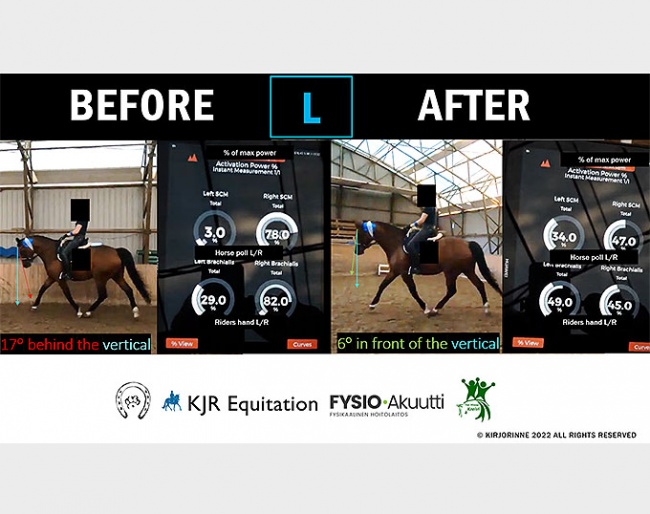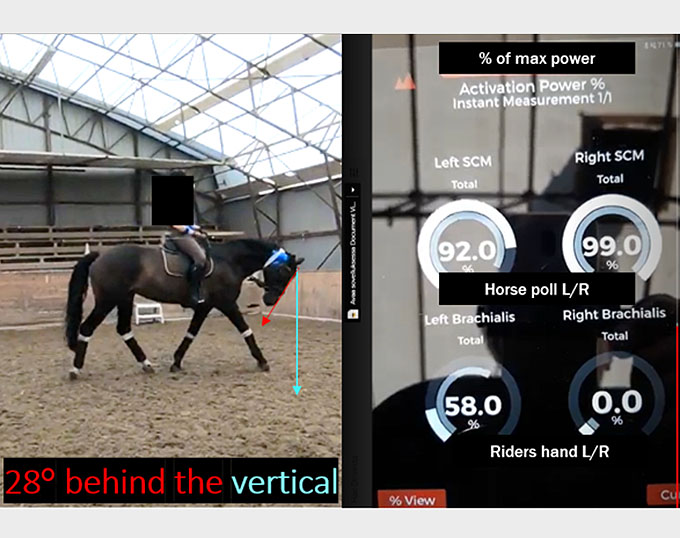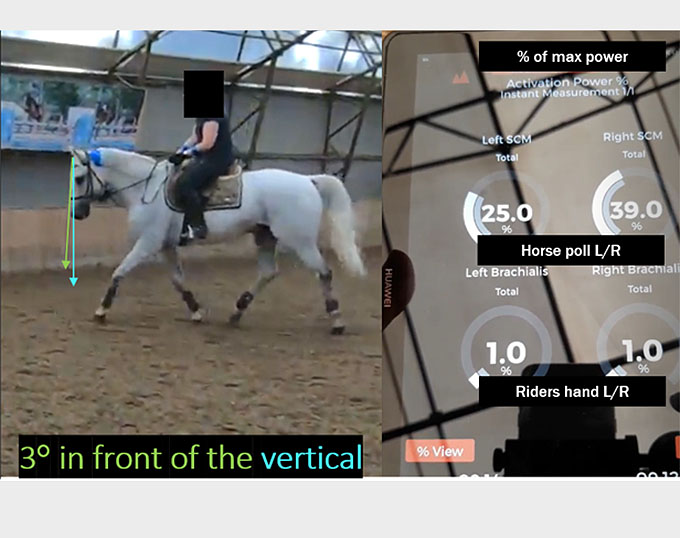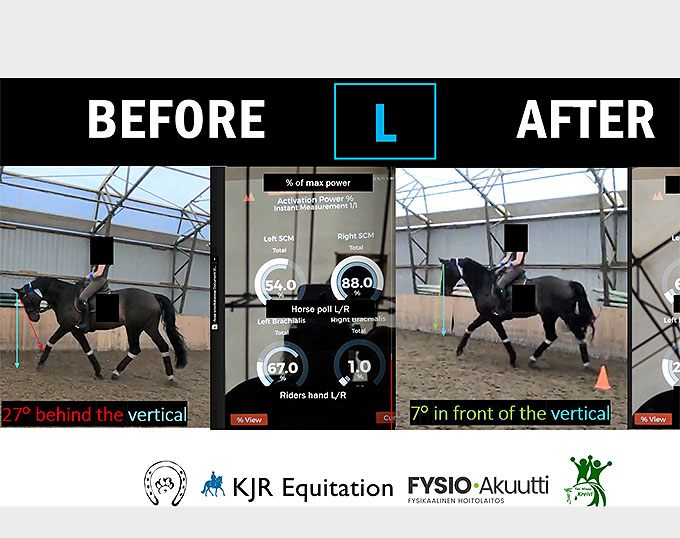
Good training respects the horse's body and mind, it’s a roadmap to progressively develop any horse from basics up to any level suitable for this individual.
Dressage training is logical when the training at home supports the goal. For dressage the goal is defined in FEI Dressage Rules. The rules highlight the welfare of the horse, and the correct frame is also very clearly defined – the horse should remain in front of the vertical or become close to the vertical. Why are so many riders then trying to achieve something else in their training at home?
For some horses it’s easy to move behind the vertical, but even if this feels easy, it has surprisingly negative effects on the muscle activity and therefore this habit should be corrected at its early phase. The body is capable to adapt even to the harmful postures which may lead to non-healthy loading of the body during a longer period of time. Some critics would say the poll position doesn’t matter that much, but there is a measurable difference that has a clear impact on the horses movement.
Where the need for testing came from

rider had tension in left hand and the horse was more tense
on the right side of the poll.
Another important thing that disturbed me was that horses that moved slightly behind the vertical could be very tense in the poll, while their experienced riders said they felt the horse was quite relaxed. Every time the frame was opened, the poll actually got relaxed. To understand this better, we decided to have a closer look at this with a team of experts – trainer, physiotherapists, animal physiotherapists and a veterinarian.
The test
We tested a group of 11 volunteer riders and their own horses to look at the symmetry, muscle activity and rein pressure. We followed them first in walk, trot, and canter on a circle in both directions. After that we tested different corrections with different riders. We picked three different horses to compare the effects of the frame when the horse was moving behind and in front of the vertical. The horses were adult horses, advanced in their own discipline - two competing in dressage and one in showjumping.
We then followed the riders trotting on a circle in both directions. When the horse was moving behind the vertical, we asked the rider to open the frame, from behind the vertical to in front of vertical. We followed the muscle activity in the horses’ poll and the riders’ hand before and after the correction
The technical equipment and placement of sensors

front of the vertical, the poll got more relaxed and the rider's hands
became relaxed.
We also placed sEMG sensors on the rider. We chose the lateral side of forearm (m. Brachioradialis) because this area typically activates when the rider is using rein aids. The placement of sensors was checked before the ride by physiotherapists.
We were also following rein pressure to confirm that the rider wasn't using any force that would affect the horse’s position.
The correction technique
The riding technique is simple and classically well known. Gentle, quick and precise, forward-upward lifting rein aid, that encourages the horse to open the frame. After the lifting rein, a leg aid can be used if needed. After the correction the rider’s hand returns to its normal position. The test was done in trot on a circle in both directions. We asked the riders to open the frame to the position that is defined in the FEI dressage rules. The technique was shown to the riders before testing the change of frame, and they were using it approximately 10 times per direction.
The results
We could see that before the correction the horses were moving behind the vertical, with a light rein contact. There were some differences in the muscle activity of the rider’s hand before the correction. When horses were moving behind the vertical, even with a very light contact, they were showing significant muscle tension in the upper neck above the atlas joint (C1). We could see even 90-99% activation values of the specific muscles maximum activation. This kind of maximal tension would absolutely affect the movement strategy and biomechanics of the horse. With all horses it was clear that they were not actively asked to move behind the vertical because of rein aids during this test, yet the horses were routinely seeking this head and neck position that was 16-28 degrees behind the vertical.

27 degrees behind the vertical with very light contact, but the
poll was tense and rider was having tension on the left hand.
After correction the horse was moving 7 degrees in front of the
vertical, the poll was relaxed and the riders left hand
relaxed too.
Role of rider's hand
The classical seat is an important foundation for the good and sensitive use of the hand, which is part of the rider’s seat. The hand must remain as relaxed as possible so that the rider is able to use the fine motor skills properly. The muscles of the hand and the arm are activated when rider is communicating with the horse. It is important that the rider is using the hand precisely and is releasing the aids as quickly as possible. Any tension in the body is forwarded into the hand, and tense hands block the rider’s seat. Precise and soft rein contact enables sophisticated communication, and gives valuable information of the horse’s balance to the rider. A balanced horse doesn't take support from the rider’s hand and holds up his body with ease.
Veterinarian's comment on the functional anatomy
"When the horse is moving behind the vertical line, tension on the area of poll and neck is created. Equine poll and neck tension have a direct influence on the biomechanics of the vertebral column and both front and hind legs. For example, tension in the area of M. brachiocephalicus upper insertion influences protraction of the front leg and creates shorter and higher stride length resulting in increased injury risk due to overuse. Soft and relaxed muscles in the poll and neck area makes breathing easier due to open air ways, neck and front leg movement more elastic , increasing bone and joint health," Finnish veterinarian Jaana Tainio commented.
Take home message
Moving behind the vertical seems to create a high muscle tone at the sensitive upper neck and poll area, even when the horse seems relaxed to the rider. A high muscle tone and a static movement strategy challenges the biomechanics, balance and proprioception of the movement and can lead to compensations and increased loading. The frame in front of the vertical, as described in FEI dressage rules and when correctly used, allows the horse to use the body in a way that is beneficial for a healthy, natural and balanced movement. This supports the goal, which is a happy equine athlete.
Measuring team:
Trainer and animal physiotherapist: Niina Kirjorinne
Physiotherapist and animal physiotherapist: Eija Nordlund
Physiotherapist: Minna Kreivi
Veterinarian: Jaana Tainio, (DVM, cert animal chiropractor)
- Niina Kirjorinne
Related Links
Why So Round? Open the Frame!
Noseband and Poll Pressures Underneath Bitless Bridles Measured
The Dilemma of Pads and Nosebands